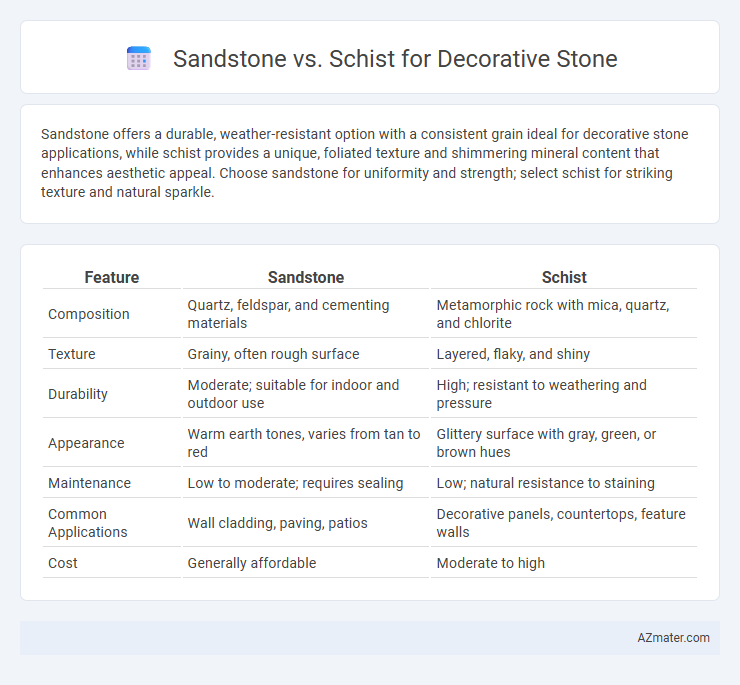Sandstone offers a durable, weather-resistant option with a consistent grain ideal for decorative stone applications, while schist provides a unique, foliated texture and shimmering mineral content that enhances aesthetic appeal. Choose sandstone for uniformity and strength; select schist for striking texture and natural sparkle.
Table of Comparison
| Feature | Sandstone | Schist |
|---|---|---|
| Composition | Quartz, feldspar, and cementing materials | Metamorphic rock with mica, quartz, and chlorite |
| Texture | Grainy, often rough surface | Layered, flaky, and shiny |
| Durability | Moderate; suitable for indoor and outdoor use | High; resistant to weathering and pressure |
| Appearance | Warm earth tones, varies from tan to red | Glittery surface with gray, green, or brown hues |
| Maintenance | Low to moderate; requires sealing | Low; natural resistance to staining |
| Common Applications | Wall cladding, paving, patios | Decorative panels, countertops, feature walls |
| Cost | Generally affordable | Moderate to high |
Introduction to Sandstone and Schist
Sandstone is a sedimentary rock composed mainly of sand-sized mineral particles or rock fragments, prized for its durability and natural earthy tones that complement outdoor and indoor decorative stone applications. Schist, a metamorphic rock characterized by its foliated texture and abundant mica minerals, offers a distinctive, shiny appearance and a range of colors ideal for textured and visually dynamic stone surfaces. Both sandstone and schist provide unique aesthetic qualities and functional benefits that influence their selection in architectural and landscaping projects.
Geological Formation and Characteristics
Sandstone forms from compacted sand-sized mineral particles and often exhibits a granular texture with varying colors depending on its mineral content, making it a durable yet softer choice for decorative stone. Schist originates from metamorphic processes involving heat and pressure, resulting in a foliated texture with visible mica flakes that give it a shimmering appearance and increased hardness. The geological formation of sandstone involves sedimentary deposition, while schist's formation through metamorphism imparts greater structural strength and unique visual patterns ideal for distinctive architectural applications.
Physical Appearance and Color Variations
Sandstone exhibits a granular texture with warm earthy tones like tan, brown, and reddish hues, often featuring layered patterns ideal for rustic designs. Schist, characterized by its foliated structure and shiny mica flakes, offers a more varied color palette including silver, gray, green, and purple shades, providing a striking visual contrast. Both stones are favored in decorative applications for their unique textures and diverse color variations, influencing aesthetic choices in interior and exterior design.
Durability and Weather Resistance
Sandstone offers moderate durability with its fine to medium grain, making it suitable for decorative applications in dry climates but prone to erosion and weathering in harsh conditions. Schist, characterized by its foliated texture and higher mineral content, exhibits superior weather resistance and strength, ensuring better longevity for exterior decorative stone under variable weather conditions. The mineral composition of schist, often rich in mica and quartz, enhances its resistance to moisture absorption and mechanical wear compared to the more porous nature of sandstone.
Workability and Ease of Installation
Sandstone offers superior workability due to its softer composition, allowing for easy cutting and shaping, which reduces installation time and effort. Schist, characterized by its foliated texture and hardness, requires specialized tools and skills to handle, making it less convenient for quick installations. Choosing sandstone for decorative stone projects enhances efficiency and flexibility, especially in intricate designs or custom fits.
Maintenance Requirements
Sandstone, composed mainly of quartz and feldspar, requires regular sealing to protect against weathering and staining, as its porous nature can absorb moisture and dirt. Schist, characterized by its foliated texture and higher hardness due to mica and quartz content, demands less frequent sealing but may need periodic cleaning to remove surface debris lodged in its layers. Both stones benefit from gentle cleaning methods to preserve their aesthetic appeal and structural integrity over time.
Applications in Decorative Stone Projects
Sandstone offers a versatile and durable option for decorative stone projects, popular for outdoor applications such as patios, garden paths, and wall cladding due to its natural textures and weather resistance. Schist, characterized by its unique foliated appearance and reflective mica content, is favored for interior decorative features like accent walls, fireplaces, and countertops, providing a distinctive, elegant aesthetic. Both stones provide distinct visual and functional qualities, allowing designers to tailor choices based on project requirements and desired ambiance.
Cost Comparison and Availability
Sandstone generally offers a lower cost and wider availability compared to schist, making it a more budget-friendly option for decorative stone projects. Schist, characterized by its foliated texture and unique mineral composition, usually commands higher prices due to limited quarry sources and increased processing requirements. Availability of sandstone is widespread across various regions, while schist deposits tend to be more geographically restricted, impacting both cost and supply consistency.
Environmental Impact and Sustainability
Sandstone is a sedimentary rock formed from compacted sand grains, generally requiring less energy to quarry and process compared to schist, a metamorphic rock characterized by its foliated texture and mineral content. The extraction of sandstone typically results in lower carbon emissions due to simpler mining techniques, while schist quarrying often involves more intensive crushing and cutting processes, increasing its environmental footprint. Sandstone's durability and lower energy demand make it a more sustainable choice for decorative stone applications when prioritizing reduced ecological impact.
Choosing the Right Stone for Your Project
Sandstone offers a warm, earthy appearance with its fine texture and varied color palette, making it ideal for natural, rustic decorative stone projects that require durability and ease of shaping. Schist, characterized by its foliated structure and shimmering mineral flakes, provides a unique, textured aesthetic perfect for adding visual interest and elegance to walls and pathways in both indoor and outdoor settings. Prioritize sandstone for structural stability and schist for distinctive surface detail, ensuring the choice aligns with the aesthetic and functional demands of your project.

Infographic: Sandstone vs Schist for Decorative Stone
 azmater.com
azmater.com